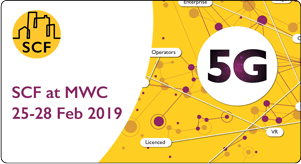By Caroline Gabriel.
Another Mobile World Congress has been and gone, and it was encouraging to see how many of its key themes aligned with SCF’s key work items.
The tone of the show was reflective – fewer big news items or grand visions than in some years, but a strong will, among all stakeholders, to make 5G work. In conversations with operators, vendors, integrators and developers, the topics of discussion were the same. What is really happening with 5G densification? What are the timelines, the commercial objectives and what needs to be addressed to make those happen?
Dominant themes that emerged in these discussions were deployment models for dense city networks and for enterprise cellular; the disaggregation of the mobile network; and the urgent need for a reformed regulatory environment to ease roll-out of small cells at scale.
These themes correlate very well with key activities within the Forum. In the area of deployment models, for instance, SCF pioneered the idea of neutral host or multi-operator dense HetNets, and this is now coming into its own. It is clear that rolling out very dense networks in cities, or specialized enterprise systems, will not be economically viable if each MNO has to deploy its own system. So neutral host is a growing theme for the Forum’s members, and many people asked us about it in Barcelona – what are the technologies and the regulations, where does an MNO fit into the value chain?
In some vertical industries, the neutral host concept will support private cellular networks within an enterprise’s locations, optimized for its particular requirements and increasingly integrated with edge compute. The use of private LTE, and in future 5G, to deliver customized applications, and keep data secured on-site, was one of the hottest topics at MWC. The Forum has already set up work items focused on neutral host, private enterprise networks and monetization opportunities for edge compute – all these topics, judging from the response in Barcelona, will become even more important to our members in the year ahead.
Another important issue for densification, especially in cities, is the regulatory environment. There was a lot of interest in the recent work SCF has done to lobby governments, with the aim of encouraging a light-touch approach to small cell site and equipment approvals. This would exempt products, provided they conformed to certain rules on size, power and mounting, from a long regulatory process, and encourage a global industry based on standard product guidelines.
SCF has already input to the rule-making by the USA’s FCC in this area, and is taking part in discussions at the European Commission. In conversations with companies from Latin America at the show, it was clear that the ambitious plans for smart cities in some parts of that region have been held back by the regulatory issues. We at the Forum hope to be able to share the best practices we have learned from our various regulatory engagements with stakeholders in that region, and other markets where governments are starting to recognize the socio-economic potential of smart cities, and the need to facilitate them with friendly regulations.
Finally, it was hard to talk to any vendor or operator without the issues of virtualized, disaggregated networks coming up. These architectural changes are central to 5G, but some MNOs are starting to implement them in 4G, often beginning with small cell networks, where the impact can be seen more quickly. The Forum is making a significant contribution to this development with its FAPI and nFAPI activities. FAPI was developed as an open interface for small cell silicon, originally in 3G, and now 4G, with 5G in the pipeline, and it provides one option for the functional split in a disaggregated network.
These examples show how the questions that are most burning for Forum members are also the biggest talking points for the industry at large. Whether architectural, regulatory or commercial, there are major decisions to be made to ensure a strong case for 4G densification and for future 5G. Mobile World Congress was a welcome validation that SCF’s 2019 priorities align well with the requirements of the market. Now that we’re all recovered from the annual madness, it’s time for the hard work of turning these important plans into deployable realities during 2019.
